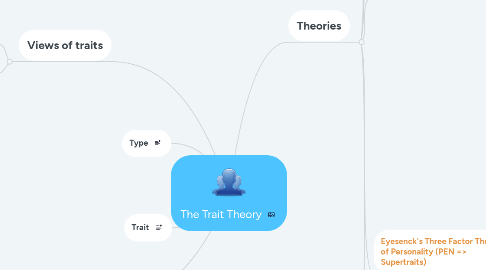
1. Trait approach
1.1. Lexical approach
1.1.1. Synonym frequency
1.1.2. Cross cultural universality
1.2. Statistical approach
1.3. Theoretical approach
2. Views of traits
2.1. Nomothetic
2.2. Idiographic
3. Theories
3.1. Hippocrates & Galen
3.1.1. Four types of people
3.1.2. Categorie Eigenschappen Lichaamssap
3.1.3. 1. Choleric Prikkelbaar Te veel gele gal
3.1.4. 2. Melancholic Depressief Te veel zwarte gal
3.1.5. 3. Sanguine Optimistisch Te veel bloed
3.1.6. 4. Phlegmatic Kalm Te veel slijm
3.2. Sheldon
3.2.1. Fysiek
3.2.1.1. Endomorphic
3.2.1.2. Mesomorphic
3.2.1.3. Ectomorphic
3.2.2. Temperament
3.2.2.1. Viscerotonic
3.2.2.2. Somatotonic
3.2.2.3. Cerebrotonic
3.3. Gordon Allport
3.3.1. Cardinal traits
3.3.2. Central traits
3.3.3. Secondary disposition traits
3.3.4. Functional Autonomy
3.4. Cattell's 16 Personality Factors
3.4.1. Common traits
3.4.2. Unique traits
3.4.3. Surface traits
3.4.4. Source traits
3.4.4.1. Environmental-mold traits
3.4.4.2. Constitutional traits
3.4.4.3. General
3.4.4.4. Specific
3.4.5. Traits op basis van uiting
3.4.5.1. Ability traits
3.4.5.2. Temperament traits
3.4.5.3. Dynamic traits
3.4.5.3.1. Ergs
3.4.5.3.2. Metaergs
3.4.6. Maatstaven van Catell
3.4.6.1. L-Data
3.4.6.2. Q-Data
3.4.6.3. OT-Data
3.5. Eyesenck's Three Factor Theory of Personality (PEN => Supertraits)
3.5.1. Hierarchisch model
3.5.1.1. Supertraits
3.5.1.1.1. Psychoticism
3.5.1.1.2. Extraversion
3.5.1.1.3. Neuroticism
3.5.1.2. Traits
3.5.1.3. Habitual response
3.5.1.4. Specific response
3.6. Big Five (McCrae & Costa)
3.6.1. Openness
3.6.2. Conscientiousness
3.6.3. Extraversion
3.6.4. Agreeableness
3.6.5. Neuroticism
3.6.6. Meetmethodes big five
3.6.6.1. NEO-PI-R
3.6.6.2. Peer ratings
3.6.6.3. Self reports
3.6.6.4. Self ratings
3.6.6.5. Observer reports
3.6.6.6. Life outcome data
3.6.6.7. Q-sorts

